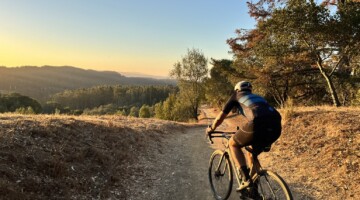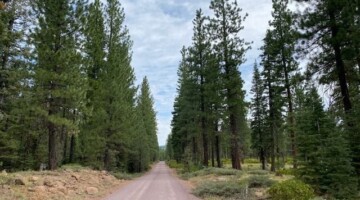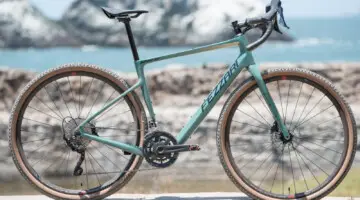by Steven L. Sheffield
BEAVER, Utah—Nestled in the Tushar Mountains, above the idyllic agricultural town of Beaver, Utah, are the roads that make up one of the most brutal events now commonly called a “gravel grinder.” Each year, roughly 600 riders choose to brave the course designed by former road professional Burke Swindlehurst in the Annual Beaver County Travel Council Crusher in the Tushar, presented by DNA Cycling.
The 69-mile course through the remote wilderness areas of Utah’s little-known Tushar Mountains and Fishlake National Forest features a near-perfect 50/50 split of paved and dirt roads spanning two counties and approximately 10,000 vertical feet of climbing, before finishing at Eagle Point Ski Resort, with a summit just under 10,400 feet.
For the sixth edition of the race, which took place this past Saturday, July 9, lining up in the Pro/Open men’s field were 2015 winner Robbie Squire (Holowesko/Citadel) alongside two-time (2014-2015) runner-up Jamey Driscoll (Raleigh-Clément), three-time Olympian Todd Wells (SRAM-TLD), former World Tour professional rider David Zabriskie (DZ Nuts), and as a way of testing his form after a serious injury earlier this year, Josh Berry (Jelly Belly-Maxxis) made his Crusher debut.
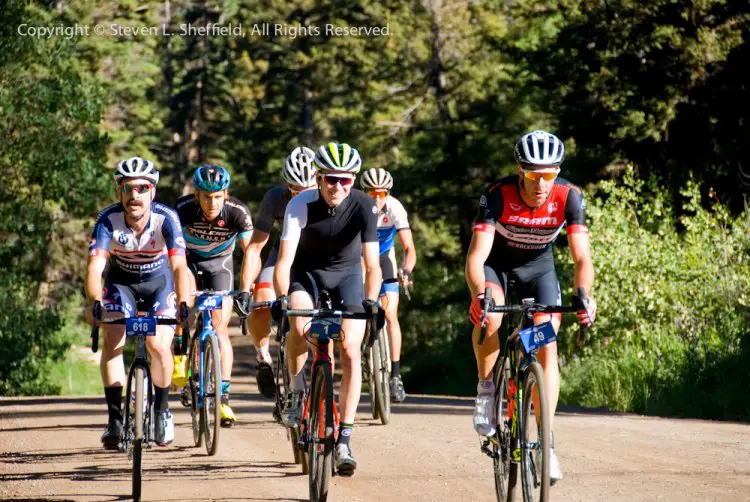
Lead group of six in the Men’s Pro field nearing the top of the first climb. From L-R: Michael Burleigh, Jamey Driscoll, Dave Zabriskie (obscured behind Robbie Squire), Robbie Squire, Leroy Popowski, Todd Wells. 2016 Tushar Crusher. Photo courtesy Steven L. Sheffield
Shortly after what was supposed to be an easy roll-out, Crusher veteran Benjamin Blaugrund (Juwi Solar) launched what has become his signature move by attacking early on the pavement. While this move has worked for Blaugrund in the past, netting him a podium position and the KOM in 2011, this year the field wasn’t having it, and reeled him back in before the first section of dirt, shedding several riders along the way.
Once the riders hit the dirt, the field began to splinter as everyone adjusted to the change in road conditions as the road pitched upwards. Initially, a group of six formed at the front, containing Squire, Driscoll, Todd Wells, Zabriskie, Leroy Popowski (Juwi Solar), and Michael Burleigh (Canyon Bicycles-Shimano), with Jake Wells (Tokyo Joe’s) and Andrew Dorais (Contender Bicycles) chasing. Blaugrund and Neil Shirley (Road Bike Action) were slightly further back. Bryan Lewis (Team Lupus) managed to reattach himself to the leader’s group as the race began to approach the top of the first climb.
As the road started to dip downwards for the slight descent into the feed zone at Betenson Flat, Dorais punctured and had to drop out of the group to make a repair. Leroy Popowski, who rode mountain bikes in all his previous attempts on the Crusher, looked a little uncomfortable descending in the loose gravel on the cyclocross bike he had chosen to ride this year, fading off the back of the lead group.
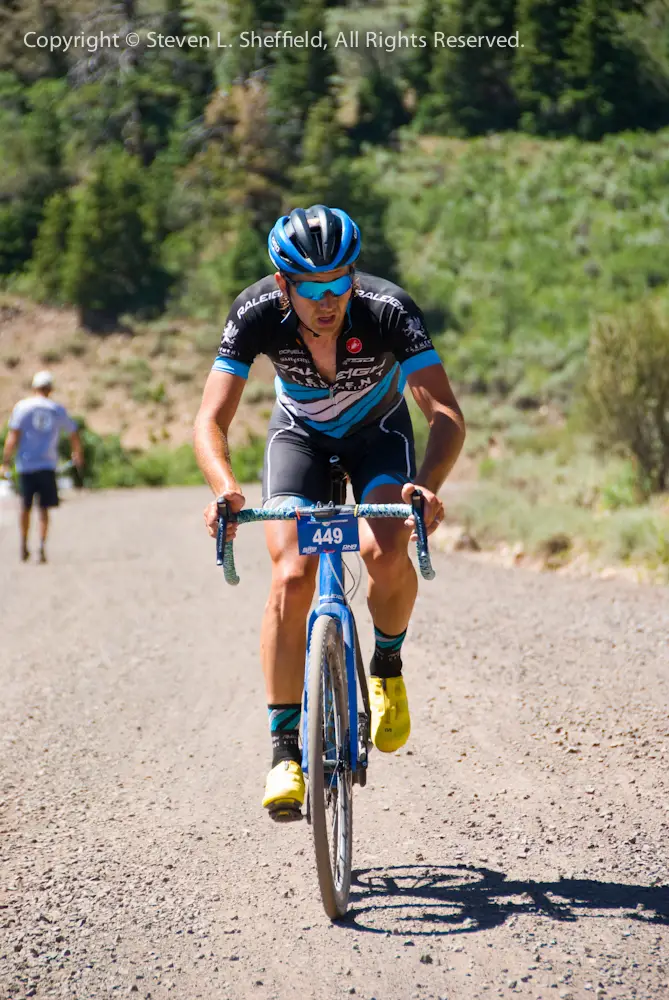
Jamey Driscoll about halfway up the Col d’Crush. 2016 Tushar Crusher. Photo courtesy Steven L. Sheffield
Once the nine remaining riders in the lead group hit the descent of the unpaved Utah State Highway 153, afterburners were lit, and they disappeared in a cloud of dust, first shedding Blaugrund and then Zabriskie, who went into a deep aero tuck as he hit the pavement to attempt to regain the lead group. Further down the road, the lead group of seven formed a rotating echelon to fight the wind as they rolled into Circleville. Blaugrund managed to claw his way onto Zabriskie’s wheel, and with Zabriskie in full time-trial mode, the two riders were able to reattach to the paceline for the remainder of the pavement on US 89 through the town of Junction, before heading back onto the dirt.
According to Squire, “The group was pretty big, and when we were on the flats going in to Circleville I was actually impressed, I think I counted 9 guys, which is maybe the biggest it’s every been in the road part near Circleville and Junction. Luckily everybody was pretty cool when we were rotating around; no one sat on or tried to put anyone into the gutter or anything lame like that, so the wind didn’t play too much of a factor for anybody at that point.”
The next section of the race, on Doc Springs Road, is feared by many riders, who have often referred to it as the infamous “Sarlacc Pit” due to its often soft, sandy surface and full exposure to the sun. While the pit caused few problems in 2015, with near-perfect conditions due to recent rains, this year it was back with a vengeance. While not as rutted out as it has been in previous years, there were few clean lines. Said Squire,
“Doc Springs is just deceptively hard. No one really thinks about it as much because of the focus on the Col d’Crush, but that’s where it breaks apart every year.”
As the road looped around, Squire began to apply some pressure in roughly the same place as 2015, and the group began to come apart, first shedding Jake Wells, then a group of four containing Blaugrund, Zabriskie, Shirley, and Lewis. Todd Wells and Burleigh both managed to hold Squire’s wheel as they made the turn back onto Utah 153 for the aptly named “Col d’Crush.”
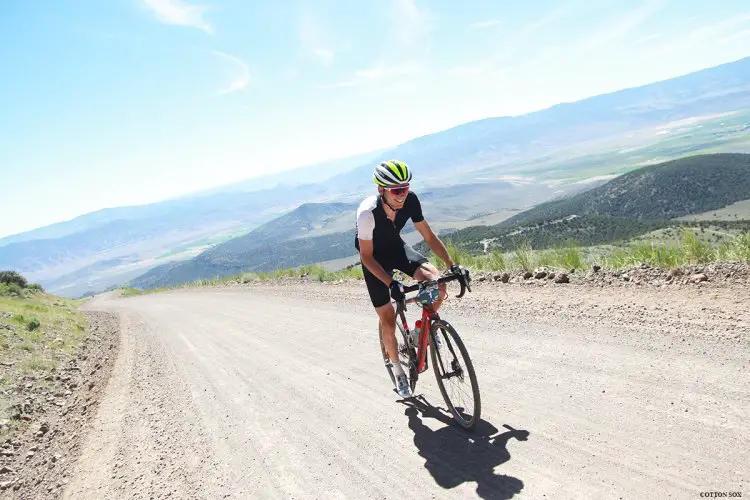
Rob Squire crushing the Col d’ Crush with a smile. 2016 Tushar Crusher. Photo courtesy Catherine Fegan-Kim (Cotton Sox Photography)
As the road pitched up upwards, Squire’s climbing talent once again began to shine as he soon distanced Wells and Burleigh, opening a gap of nearly 4 minutes by the time he claimed the KOM prize at 13 miles to go.
“With Todd (Wells) I was faster on the uphill, and I thought he was playing tactics with me, like ‘oh I’m not going to help that much on the climbs’ and I thought ‘well, um … great,” so I just tried to go as hard as I could because he is much faster in the corners and on the flats. I just tried to keep away with everything I had.”
The pain didn’t stop there, however, as Squire and the rest of the riders still faced another 1,000 feet of climbing back to Betenson Flat before turning north towards Big Flat, which had recently been graded and resurfaced with a fresh layer of large gravel, making the final section of dirt even more leg-sapping than usual.
“Actually, it’s funny,” continued Squire, “my favorite part of the race was coming through this section and seeing Burke’s little ‘Welcome to Hell’ sign with his face all covered in red. I laughed pretty good at that.”
For the final sting in the tail, Squire still faced another 10% average climb over the last mile before crossing the finish line at Eagle Point Ski Resort in 4:12:31.
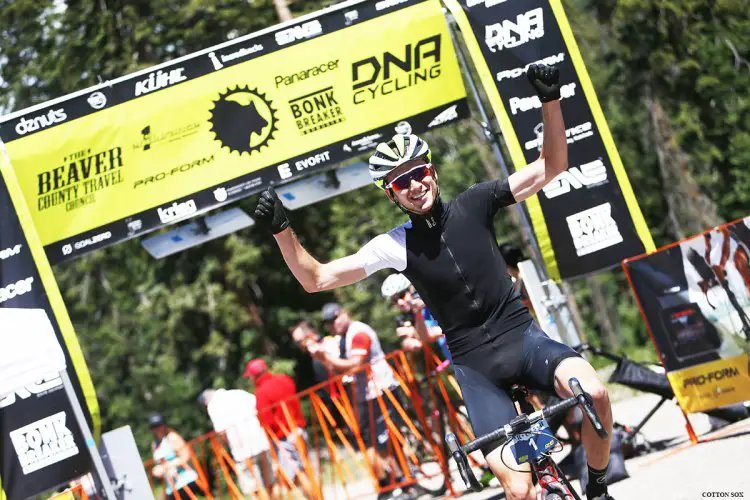
Rob Squire wins Crusher in the Tushar. 2016 Tushar Crusher. Photo courtesy Catherine Fegan-Kim (Cotton Sox Photography)
Further down the mountain, Canyon’s Michael Burleigh flatted, but managed to fix the flat and get up and rolling again fairly quickly to get back to Todd Wells, allowing himself to recover a bit on Wells’ wheel as they came towards the finish. With about 100 feet to go, the mustachioed Burleigh launched his sprint to the line, holding off Wells by a whisker to claim second, with both riders awarded the same time of 4:21:14.
Said Burleigh, “I was off the front coming into the base of the Col d’Crush with Robbie and Todd and then I flatted, and so I had to stop at one of the stations and pump my tire back up. Luckily, the sealant worked and it did reseal, but I lost more than a minute. At point all you can really do is stay calm, and knowing you still have to pull the riders in front of you back. I spent all the bullets I had except for one to get back to Todd. I pretty much sucked his wheel all the way after that, honestly. We were well ahead of everybody else, and given that I had flatted, I didn’t feel too bad about just sucking his wheel until the sprint.”
Josh Berry (Jelly Belly-Maxxis), who had been dropped from the lead group early, showed that his post-injury form was coming on strong, finishing shortly after Burleigh and Wells in fourth place in 4:23:54, while Raleigh’s Jamey Driscoll managed to hold on to fifth place in 4:26:13.
Rounding out the top-ten were Bryan Lewis (6th), followed by Leroy Popowski (7th) who made up the time lost on the descent on his way back up the Col d’Crush, Neil Shirley (8th), Benjamin Blaugrund (9th), and Jake Wells (10th).
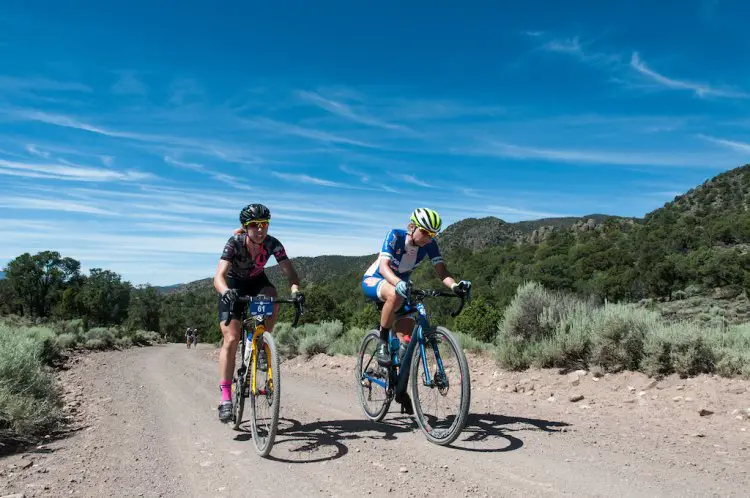
Mindy McCutcheon, left and Robin Farina, right rode side by side for most of the day neither yielding until the slopes of Col D Crush where McCutcheon soloed away for the win. Here the two racers are on Doc Springs Road (also known as the Sarlacc Pit). 2016 Tushar Crusher. Photo courtesy Christopher See
Starting a minute after the Pro/Open Men, the Pro/Open Women was stacked with talent as well, featuring former US National Road Race Champion and 2015 winner and course record holder Robin Farina (Panaracer-Stan’s No Tubes), who also won this year’s Lost & Found gravel race, two-time podium finisher and Women’s 30-34 Cyclocross National Champion Mindy McCutcheon (DNA Cycling-Cotton Sox) along with her teammates Beth Ann Orton and Anna Grace Christiansen, and 2015 runner-up Mindy Caruso (Nero Veloce).
On the first climb Farina and McCutcheon worked well together shedding the rest of the field by the time they crested. About halfway through the race, however, McCutcheon experienced some mechanical problems with her Shimano Di2 drivetrain and dropped her chain. By the time she got her chain back on and going again, she lost time to Farina.
“Robin and I pulled away on the first climb, and we worked really well together, but coming down the Col d’Crush I started having some shifting & mechanical issues. My chain had a little too much slack in it and got wrapped around my pedal and my crank and everything went all to crap. So at the bottom of the Col d’Crush, I had to get off my bike and untangle everything and then put my chain back on.”
Unfortunately, this was not the end of McCutcheon’s troubles, as her drivetrain continued to cause her problems for the remainder of the race.
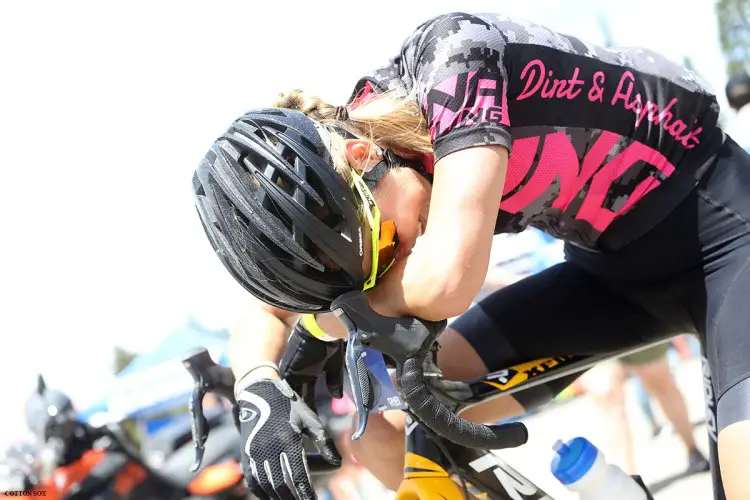
Mindy McCutcheon (DNA Cycling – Cotton Sox) winner Pro Women. 2016 Tushar Crusher. Photo courtesy Catherine Fegan-Kim (Cotton Sox Photography)
“I got in with a really strong group of guys in Circleville and managed to catch back on to Robin in the Sarlacc Pit and we started climbing back up the Col d’Crush together, but the whole time for 35 miles my shifting was just going ‘clunk clunk clunk clunk clunk’ and I couldn’t climb out of my saddle at all, I thought I’d break my derailleur off, so I had no idea if I could even finish at all, much less pull off a win.”
McCutcheon was able to channel her anger at her mechanical issues into her effort, and eventually, she was able to get some separation from Farina on the climb back up the Col d’Crush.
“The mechanical issues pissed me off enough and distracted me enough from my body hurting, I think that played to my advantage; I was just so angry I just put everything into climbing up that mountain. I thought for sure Robin would be able to catch back on during the downhill flowy section after Big Flat because I couldn’t really crank in a very hard gear, and maintain that very long, but luckily I did have enough gears that I was able to hold on to my lead.”
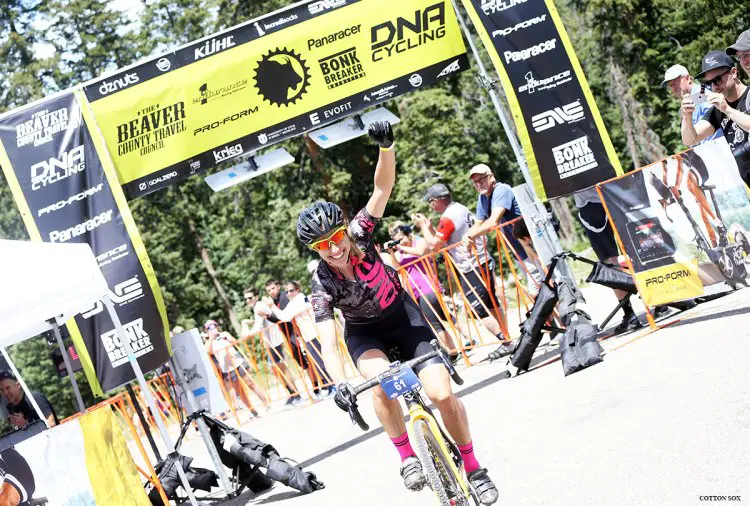
Mindy McCutcheon wins with a course record of 4:53:16. 2016 Tushar Crusher. Photo courtesy Catherine Fegan-Kim (Cotton Sox Photography)
And maintain her lead she did, taking the win and setting a new women’s course record of 4:53:16, annihilating Farina’s previous record by over 8 minutes, and improving on her own 2015 time by just under 17 minutes.
After riding a mountain bike for her first two attempts on the Crusher, when asked about how much difference riding a cyclocross bike make, McCutcheon said,
“It was huge! Last year my biggest issue was that I ran out of gears on the descent, so I couldn’t go hard enough downhill, but I had enough gears for the climbs. This year I borrowed (Visit Dallas DNA Pro Cycling co-owner) Alex Kim’s cyclocross bike and had it set up with some great gearing and it was super-light, so the bike itself was lighter, I’m a little lighter and my fitness is better, and my gearing was just perfect, aside from my shifting issues of course.”
“I definitely owe it all to DNA Cycling and Cotton Sox Photography for getting me here, getting me set-up on a bike that was Crusher-worthy; that’s the only way I could pull this off for sure.”
When asked what’s next, McCutcheon said, “Next Saturday I have the Boise Twilight Criterium and from there we go straight to Bend, Oregon for the Cascade Classic, where I get to race with my new road team!” McCutcheon recently joined the UCI-registered Visit Dallas DNA Pro Cycling team for the remainder of 2016 and 2017 seasons.
Panaracer’s Farina also improved on her 2015 time, coming in second in 4:56:09, joining McCutcheon as the only two women in the history of the race to finish in less than 5 hours. Rounding out the podium was 2015 runner-up Mindy Caruso in 5:06:43, followed by Breanne Nalder (Plan 7 DS) in fourth and Chase Edwards (Flagstaff Bike Revolution) in fifth.


























